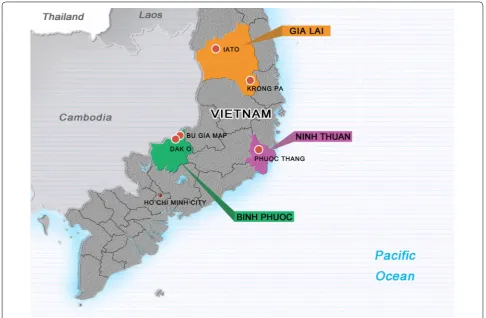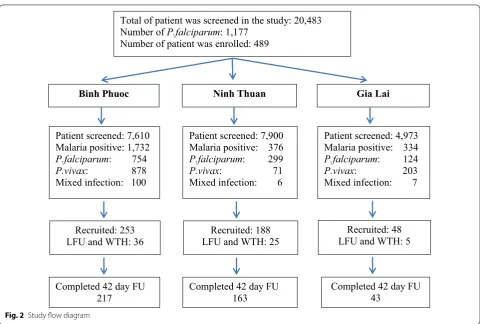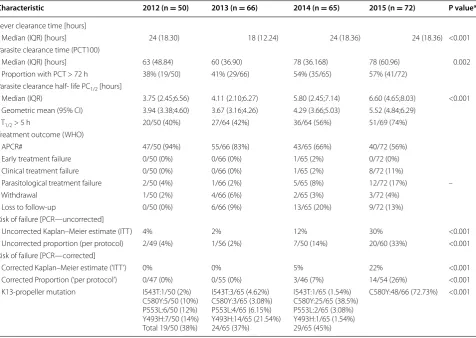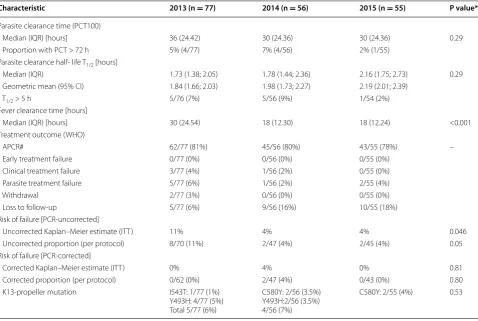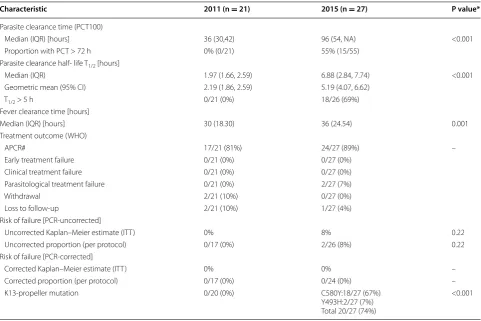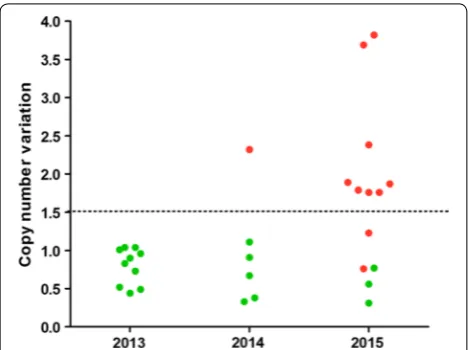RESEARCH
Rapid decline in the susceptibility
of Plasmodium falciparum to
dihydroartemisinin–piperaquine
in the south of Vietnam
Ngo Viet Thanh
1, Nguyen Thuy‑Nhien
1*, Nguyen Thi Kim Tuyen
1, Nguyen Thanh Tong
1,
Nguyen Thuy Nha‑Ca
1, Le Thanh Dong
2, Huynh Hong Quang
3, Jeremy Farrar
1,4, Guy Thwaites
1,4,
Nicholas J. White
4,5, Marcel Wolbers
1,4and Tran Tinh Hien
1,4Abstract
Background: Artemisinin resistant Plasmodium falciparum has emerged in the countries of the Greater Mekong sub‑region posing a serious threat to global malaria elimination efforts. The relationship of artemisinin resistance to treatment failure has been unclear.
Methods: In annual studies conducted in three malaria endemic provinces in the south of Vietnam (Binh Phuoc, Ninh Thuan and Gia Lai) between 2011 and 2015, 489 patients with uncomplicated P. falciparum malaria were enrolled in detailed clinical, parasitological and molecular therapeutic response assessments with 42 days follow up. Patients received the national recommended first‑line treatment dihydroartemisinin‑piperaquine for three days.
Results: Over the 5 years the proportion of patients with detectable parasitaemia on day 3 rose steadily from 38 to 57% (P < 0.001). In Binh Phuoc province, the parasite clearance half‑life increased from 3.75 h in 2011 to 6.60 h in 2015 (P < 0.001), while treatment failures rose from 0% in 2012 and 2013, to 7% in 2014 and 26% in 2015 (P < 0.001). Recrudescence was associated with in vitro evidence of artemisinin and piperaquine resistance. In the treatment fail‑ ures cases of 2015, all 14 parasite isolates carried the C580Y Pfkelch 13 gene, marker of artemisinin resistance and 93% (13/14) of them carried exoE415G mutations, markers of piperaquine resistance.
Conclusions: In the south of Vietnam recent emergence of piperaquine resistant P. falciparum strains has accelerated the reduced response to artemisinin and has led to treatment failure rates of up to 26% to dihydroartemisinin‑pipe‑ raquine, Vietnam’s current first‑line ACT. Alternative treatments are urgently needed.
Keywords: Artemisinin resistance, Piperaquine resistance, Parasite clearance half‑life
© The Author(s) 2017. This article is distributed under the terms of the Creative Commons Attribution 4.0 International License (http://creativecommons.org/licenses/by/4.0/), which permits unrestricted use, distribution, and reproduction in any medium, provided you give appropriate credit to the original author(s) and the source, provide a link to the Creative Commons license, and indicate if changes were made. The Creative Commons Public Domain Dedication waiver (http://creativecommons.org/ publicdomain/zero/1.0/) applies to the data made available in this article, unless otherwise stated.
Background
Over the past 30 years there have been substantial reductions in malaria mortality and morbidity across the Greater Mekong sub-region. This has been driven largely by increased deployment of artemisinin-based
combination therapy (ACT) for falciparum malaria which have replaced the monotherapies which suc-cessively fell to resistance. In Vietnam, the number of clinical cases of malaria decreased from 1,672,000 with 4650 deaths in 1991 to 19,252 with 3 deaths in 2015 [1]. Dihydroartemisinin-piperaquine (DP) was adopted in 2005 as first-line treatment and is the most extensively used anti-malarial drug in Vietnam. The success of the National Malaria Control Programme (NMCP) led to the initiation of “Malaria Elimination by the year of 2025,” a project endorsed with strong political commitment.
Open Access
*Correspondence: nhienntt@oucru.org
1 Oxford University Clinical Research Unit, Wellcome Trust Major Overseas
Programme, 764 Vo Van Kiet Street, Ward 1, District 5, Ho Chi Minh City, Vietnam
Neighbouring countries have also set malaria elimina-tion targets for the near future. These laudable objec-tives are now threatened by the emergence and spread of artemisinin resistant Plasmodium falciparum. First rec-ognized in Western Cambodia 10 years ago, artemisinin resistant malaria parasites are now prevalent across the Greater Mekong subregion from the Myanmar-India border in the west to the coast of Vietnam in the East [2, 3]. To characterize the extent of artemisinin resist-ance and its effects on therapeutic responses to ACT, the Global Plan for Artemisinin Resistance Containment [4] recommended regular in vivo and in vitro assessments. This study reports on the results of sequential studies conducted in the southern provinces Binh Phuoc, Ninh Thuan, and Gia Lai of Vietnam.
Methods
Study sites
The study was conducted from August 2011 to Decem-ber 2015 in (i) the Bu Gia Map and Dak O communes located in the Bu Gia Map district, Binh Phuoc province, 130 km northeast of Ho Chi Minh City and 100 km west of the Cambodian border (In 1989, Binh Phuoc was the first province in Vietnam to use artemisinin monother-apy); (ii) the IaTo commune, Ia Grai district, and then the Krong Pa Medical Center (this study site replaced the laTo site in 2012 because of slow recruitment), both are in Gia Lai province in the southern highlands; (iii) the Phuoc Thang commune, Bac Ai district, Ninh Thuan province in central Vietnam (2013–present) (Fig. 1).
Recruitment of study participants
Inclusion and exclusion criteria followed the World Health Organization’s protocol for surveillance of the therapeutic efficacy of anti-malarial medicines [5]. Patients presenting with uncomplicated P. falciparum malaria detected using microscopy, aged three years and above with an asexual parasitaemia between 10,000- and 200,000 parasites/µL were invited to participate in the surveillance program. Participants aged 15 years and above provided written informed consent. Parents or guardians granted informed consent on behalf of their children. A minimum sample of 50 patients was required for the study to be representative (n ≥ 50) [5]. We there-fore planned to enroll 50–75 subjects per site per year.
Treatment of malaria and follow‑up
Patients with uncomplicated malaria who met the study inclusion criteria were enrolled, screened, and treated on-site daily with dihydroartemisinin-piperaquine (DP) (Arterakin, CV Artecan) for 3 days, following the National Malaria Treatment Guidelines [6]. DP tablets containing 40 mg of dihydroartemisinin and 320 mg of
piperaquine phosphate were obtained from OPC Phar-marceutical Joint-Stock Company (Ho Chi Minh, Viet-nam) and distributed by the NMCP. The number of DP tablets administered at 0, 8, 24, and 48 h was adminis-tered according to body weight (Additional file 1). All doses were administered and recorded under the super-vision of a qualified member of the staff designated by the principal investigator. The subjects were observed for 30 min for adverse reactions or for vomiting after tak-ing the medication. Any patient who vomited durtak-ing this period was re-treated with the same dose and observed for a further 30 min. If vomiting occurred between 30 and 60 min after administration, half the dose was repeated. If the patient vomited again, he or she was withdrawn and offered rescue therapy. Patients were monitored for 42 days. The follow-up comprised a fixed schedule of examinations on days 3, 7, 14, 21, 28, 35, 42 and included clinical and laboratory testing. PCR genotyping was used to distinguish between recrudescence and reinfection [7].
Clinical and laboratory procedures
Microscopy examination of blood
Thick and thin blood films were examined at screening (day 0) then every 6 h until two consecutive slides were negative as well as on each day of scheduled follow up or on any other day if the patient returned and parasito-logical reassessment required. Specimens were labeled to maintain anonymity (screening or study number, day of follow-up, and date). Thick and thin blood smears were examined were stained with 10% Giemsa in pH 7.2 buffer solution for 15 min. Parasitaemia was estimated by counting the number of asexual parasites per 500 leuco-cytes in the thick blood film or per 1000 red blood cells on a thin film then calculated followed WHO guideline. All slides were read by two qualified microscopists inde-pendently, and the average of the two counts was taken as the parasite density. Blood smears with discordant results (differences in assessments of species, parasite den-sity >50%, or the presence of parasites) were re-examined by a third independent microscopist, and parasite densi-ties were calculated by averaging the two closest counts [5].
Genotyping of malaria parasites
for parasite DNA extraction and genotyping based on polymorphisms in the genes encoding the merozoite sur-face proteins MSP-2 and MSP-1 as well as GLURP follow standard procedures [7].
K13 single‑nucleotide polymorphism (SNPs) genotyping
Taqman SNP genotyping was used to detect mutations in the K13-propeller gene at the field sites within 1 or 2 days after collection. The total genomic DNA from the dried blood spot samples were extracted by a MagNa Pure 96 Instrument automated extraction system using MagNa Pure 96 DNA and Viral NA Small Volume Kit (Roche, Switzerland). Seven positions on K13-propeller gene (Y493H, R539T, I543T, P553L, C580Y, V568G and P574L) were chosen to genotyping based on result of pre-vious reports on K13 in Vietnam parasite population [8,
9]. Ten ng of DNA template was genotyped at 7 positions described above separately in 10 μL volume reactions including 0.5 μL Taqman primer probe mix (Applied Bio-systems), 5 μL Light Cycler Probe master mix (Roche, Switzerland). The cycling conditions were 10 min at 95 °C followed by 50 cycles of 15 s at 95 °C, 1 min at 60 °C and hold at 37 °C for 15 min. Allelic discrimination analysis
was performed to determine the genotype of the sam-ples. All samples with mutations and 30 samples with no mutations at 7 SNPs described above (randomly cho-sen) were retested by capillary sequencing to confirm the results of SNP genotyping.
In‑vitro susceptibility assays
Ex vivo responses to dihydroartemisinin (DHA) and in vitro reponses to piperaquine were assessed in 9/14 P. falciparum samples of recrudescence cases (collected from patients involved in the DP efficacy monitoring study in 2015–2016 in Binh Phuoc Province) by the ring stage survival assay (RSA) [10] and piperaquine survival assay (PSA) [11], respectively. The results were expressed as the survival rate of parasites after 6 h drug exposure for RSA and 48 h for PSA. The DHA and piperaquine sensitive 3D7 and K1 P. falciparum lines were used as controls in the RSA and PSA.
Piperaquine resistant marker testing
[image:3.595.55.542.87.405.2]putative exonuclease gene (exoE415G) followed a proto-col described recently [12]. Copy number of plasmepsin 2 encoding gene were detected by real time qPCR followed a procedure shared by the same group [12].
Outcome measures
The primary objective of this study was to monitor for artemisinin resistance by assessing parasite clearance times (PCT100), specifically, the proportion of patients with clearance times >72 h after starting DP treatment [13]. The PCT100 was defined as number of hours from the first treatment dose to the first of two consecutive negative thick blood films for asexual P. falciparum parasites in 500 fields. Secondary outcomes were as follows: (i) The parasite clearance half-life (PC1/2) was defined as the time for parasitaemia to decrease by 50% during the log-linear phase of parasite clearance as calculated by the WorldWide Antimalarial Resist-ance Network parasite clearResist-ance estimator [13]. (ii) The fever clearance time (FCT) was defined as the number of hours from the first treatment dose to the start of the first sustained 24 h period without fever (<37.5 °C). (iii) Treatment failure was defined according to WHO guidelines [5] [proportion of early treatment failures (ETFs), late clinical failures (LCFs), late parasitologi-cal failures (LPFs), and adequate cliniparasitologi-cal and parasito-logical responses (ACPRs) by day 42]. PCR-uncorrected and PCR-corrected failure rates were reported. Recru-descence was defined as detection of identical alleles for each of the three polymorphic markers in the pre-treatment and post-pre-treatment samples. Infections in which one or more alleles differed were classified as new infections [7]. (iv) The relationship between treat-ment outcomes and the prevalence of the K13-propeller mutations was characterized.
Statistical analysis
The proportion of subjects with a PCT >72 h was calcu-lated using the Kaplan–Meier method. The risk of treat-ment failure was estimated using the Kaplan–Meier estimator (intention-to-treat analysis) and as a propor-tion of evaluable patients only (per protocol analysis). At each site, changes in outcomes were assessed using lin-ear trend tests. Specifically, the outcome was regressed according to calendar time using the Cox proportional hazards model (parasite clearance time, fever clear-ance time, and intention-to-treat analysis of the time to treatment failure), linear regression (parasite clearance half-life), or logistic regression (per protocol analysis of treatment failures and prevalence of the K13-propeller mutation). All analyses were performed using R v.3.3.1 software (R Foundation for Statistical Computing, Vienna, Austria).
Ethics
The protocol, informed consent documents, relevant sup-porting information, and all patient recruitment informa-tion were approved by the Ethics Committees of the Ho Chi Minh and Qui Nhon Institutes of Malaria, Parasitol-ogy and EntomolParasitol-ogy and the Oxford University Tropical Research Ethics Committee. Any person who decided not to participate in the study was examined, treated, and followed by health facility staff according to the standard of care recommended by the Ministry of Health [6].
Results
Between August 2011 and December 2015, 489 patients with uncomplicated P. falciparum malaria were recruited: 253 in Binh Phuoc; 188 in Ninh Thuan; and 48 in Gia Lai. The 42-day follow-up schedule was completed by 423 (87%) subjects (Fig. 2). Adults (>15 years of age) repre-sented 77% (375/489) of the patients, and 95% (471/489) were febrile upon admission (Table 1). The proportion of patients with a microscopy detected parasitaemia on day 3 (D3) post-DP treatment was highest in the Binh Phuoc site and increased progressively with time: 38, 41, 54, and 57% in 2012, 2013, 2014, and 2015, respectively (P < 0.001) (Fig. 3). In Ninh Thuan, the percentage remained low (<10%), and the differences were not significant (P = 0.29). In Gia Lai, patients were only recruited dur-ing 2011 and 2015 The D3 positivity rates were 0% in Iato versus 55% in Krong Pa (P < 0.001). The parasite clearance half-life in Binh Phuoc increased from 3.75 h in 2011 to 6.60 h in 2015 (P < 0.001) (Tables 2, 3, 4; Fig. 3). One early treatment failure occurred at Binh Phuoc (Table 2). This patient was febrile with a positive blood smear on day 3, but recovered fully by the end of treatment. Treatment failure rates were highest in Binh Phuoc, and increased significantly over time (P < 0.001) as follows: 0% in 2012 and 2013 and 7 and 26% in 2014 and 2015, respectively (Table 2). There were only two late treatment failures in Ninh Thuan (Table 3) and none in Gia Lai (Table 4).
Samples for evaluation of mutations were available for 481 subjects. K13-propeller mutations (n = 151, 31%) were as follows: 109, C580Y; 24, Y493H; 10, P553L; 7, I543T and 1 V568G (Additional File 2). Baseline parasi-taemia was associated with the K13-propeller mutation (P value = 0.37 [linear regression, adjusted for site]). The
K13-propeller mutation (all C580Y), one did not have the mutation, and one did not provide a sample.
Ex vivo responses to DHA were measured in 64% (9/14) of P. falciparum isolates collected from recru-descent patients in 2015 by RSA and all were resistant to DHA (survival rate >1), with a median survival rate of 14.29% (IQR 4.76%, 23.51%). The 9 isolates were also tested in the PSA and all were resistant to piperaquine, with survival rate ≥10% (Fig. 4). The median survival rate after exposure to 200 nM of piperaquine was 20.72% (IQR 8.28%, 30.07%). The RSA and PSA were also carried out on isolates from two patients who experienced an ACPR response to DP.
The exoE415G mutation, which has been reported associated with increased tolerance to piperaquine [12] were found in 93% (13/14) isolates collected from recru-descent patients in 2015. Due to limited DNA amount of the recrudescent samples, plasmepsin 2 amplification was measured in 71% (10/14) of the samples. Eight of them (80%) had multi-copies of this gene (Fig. 5).
Discussion
The widespread use of artemisinin and its derivatives in Vietnam has been a major factor underlying the marked reduction in malaria mortality and morbidity in the country. Until recently the nationally recommended
Total of patient was screened in the study: 20,483 Number of P.falciparum: 1,177
Number of patient was enrolled: 489
Gia Lai
Patient screened: 4,973 Malaria positive: 334 P.falciparum: 124 P.vivax: 203 Mixed infection: 7
Recruited: 48 LFU and WTH: 5
Completed 42 day FU 43
Ninh Thuan
Patient screened: 7,900 Malaria positive: 376 P.falciparum: 299 P.vivax: 71 Mixed infection: 6
Recruited: 188 LFU and WTH: 25
Completed 42 day FU 163
Binh Phuoc
Patient screened: 7,610 Malaria positive: 1,732 P.falciparum: 754 P.vivax: 878 Mixed infection: 100
Recruited: 253 LFU and WTH: 36
Completed 42 day FU 217
Fig. 2 Study flow diagram
Table 1 Patient characteristics at enrolment sites in Vietnam
Characteristic Binh Phuoc
(N = 253) NinhThuan (N = 188) Gia Lai(N = 48)
Age [years]–median (IQR) 24 (18.33) 16 (10.26) 27 (22.29)
Children 3–14 years old‑n (%) 23/253 (9.1%) 89/188 (47.3%) 1/48 (2.1%)
Female gender–n (%) 39/253 (15%) 70/188 (37%) 3/48 (6%)
Temperature [°C]–median [IQR] 39.0 (38.3–39.5) 38.8 (38.0–39.5) 39.5 (39.0–40.0) Parasitaemia [parasites/µL]–median (IQR) 50,240
[image:5.595.58.539.84.408.2] [image:5.595.55.546.451.549.2]ACT, dihydroartemisinin-piperaquine, retained excellent efficacy throughout the country.
Since the first recognition of artemisinin resistance in Cambodia, studies have been conducted to assess whether resistance had emerged in or spread to Vietnam, and what impact that would have on treatment efficacy. In 2010–2011, a randomized controlled clinical trial of 166 patients with uncomplicated P. falciparum malaria in the Binh Phuoc area showed that the proportion of patients with parasite clearance times >72 h ranged from 22 to 25%, depending on the dose of artesunate given (2 or 4 mg/kg/day). The corresponding median parasite clearance half-lives (PC1/2) for were <5 h. Both indicated a high prevalence of slow parasite clearance. Although there were two ETFs (4%) and one late clinical failure (2%) in the lower dose artesunate (2 mg/kg/day) group, the PCR-corrected ACPR rates in the three groups were 94, 100, and 100% [14, 15]. This showed that artemisinin Fig. 3 Proportion of patients with positive smear on day 3, parasite
clearance half‑life (PC1/2) and the treatment failure rate follow‑ ing dihydroartemisin–piperaquine treatment in Binh Phuoc from 2012–2015 in Vietnam
Table 2 Annual clinical and parasite responses to dihydroartemisinin-piperaquine treatment of uncomplicated Plasmo-dium falciparum malaria in Binh Phuoc province, Vietnam
* P values are based on linear trend tests
APCR adequate clinical and parasitological responses
Characteristic 2012 (n = 50) 2013 (n = 66) 2014 (n = 65) 2015 (n = 72) P value*
Fever clearance time [hours]
Median (IQR) [hours] 24 (18.30) 18 (12.24) 24 (18.36) 24 (18.36) <0.001 Parasite clearance time (PCT100)
Median (IQR) [hours] 63 (48.84) 60 (36.90) 78 (36.168) 78 (60.96) 0.002 Proportion with PCT > 72 h 38% (19/50) 41% (29/66) 54% (35/65) 57% (41/72)
Parasite clearance half‑ life PC1/2 [hours]
Median (IQR) 3.75 (2.45;6.56) 4.11 (2.10;6.27) 5.80 (2.45;7.14) 6.60 (4.65;8.03) <0.001 Geometric mean (95% CI) 3.94 (3.38;4.60) 3.67 (3.16;4.26) 4.29 (3.66;5.03) 5.52 (4.84;6.29)
T1/2 > 5 h 20/50 (40%) 27/64 (42%) 36/64 (56%) 51/69 (74%) Treatment outcome (WHO)
APCR# 47/50 (94%) 55/66 (83%) 43/65 (66%) 40/72 (56%)
Early treatment failure 0/50 (0%) 0/66 (0%) 1/65 (2%) 0/72 (0%) Clinical treatment failure 0/50 (0%) 0/66 (0%) 1/65 (2%) 8/72 (11%)
Parasitological treatment failure 2/50 (4%) 1/66 (2%) 5/65 (8%) 12/72 (17%) –
Withdrawal 1/50 (2%) 4/66 (6%) 2/65 (3%) 3/72 (4%)
Loss to follow‑up 0/50 (0%) 6/66 (9%) 13/65 (20%) 9/72 (13%) Risk of failure [PCR—uncorrected]
Uncorrected Kaplan–Meier estimate (ITT) 4% 2% 12% 30% <0.001
Uncorrected proportion (per protocol) 2/49 (4%) 1/56 (2%) 7/50 (14%) 20/60 (33%) <0.001 Risk of failure [PCR—corrected]
Corrected Kaplan–Meier estimate (‘ITT’) 0% 0% 5% 22% <0.001
Corrected Proportion (‘per protocol’) 0/47 (0%) 0/55 (0%) 3/46 (7%) 14/54 (26%) <0.001 K13‑propeller mutation I543T:1/50 (2%)
C580Y:5/50 (10%) P553L:6/50 (12%) Y493H:7/50 (14%) Total 19/50 (38%)
I543T:3/65 (4.62%) C580Y:3/65 (3.08%) P553L:4/65 (6.15%) Y493H:14/65 (21.54%) 24/65 (37%)
I543T:1/65 (1.54%) C580Y:25/65 (38.5%) P553L:2/65 (3.08%) Y493H:1/65 (1.54%) 29/65 (45%)
[image:6.595.55.290.88.250.2] [image:6.595.60.537.347.685.2]resistance was present in Vietnam but had not yet affected the efficacy of the first-line treatment.
This study reports longitudinal clinical, parasitological and molecular surveillance over a five year period from malaria endemic areas in the south of the country close to Eastern Cambodia. In Binh Phuoc province between 2012 and 2015 the proportion of patients with parasites still present on day 3 after starting DP treatment has pro-gressively increased from 38 to 57%, with a correspond-ing reduction in cure rates from 0 to 26% (PCR corrected as per protocol). It provides unequivocal evidence of worsening artemisinin resistance and it shows that this has recently been associated with a rapid deterioration in the efficacy of DP. This strongly suggests that piperaquine resistance has arisen upon a background of artemisinin resistance reported recently from Cambodia [16]. The in vitro and molecular studies provided support for this; all patients who failed treatment were infected with K13 mutated parasites, and the parasites from recrudescent infections had median in vitro PSA survival rate of 39.2% compared with 0.17% in the patients who were cured
with DP. Artemisinin-resistant K13 mutants with ex vivo PSA survival rates ≥10% were associated with a 32-fold higher risk of recrudescence [11]. It is notable that all 14 recrudescent patients in 2015–2016 were infected with the C580Y PfK13 genotype, which may indicate a recent hard selective sweep by a successful multi-drug resistant lineage.
While piperaquine was effective the DP combination provided high cure rates, but the reduced anti-malar-ial effect associated with artemisinin resistance places greater selection pressure on the partner drug, and when resistance to that occurs, the combination predictably fails. The detection of markers for piperaquine and DP treatment failure in the recrudescent patients also sup-ported this. Among all the tested recrudescent para-sites collected in 2015–2016, 93% (13/14) of them have exoE415G mutations and 80% (8/10) have multi copies of the plasmepsin 2 gene. It may indicate that resistance to piperaquine occurred. There has been insufficient attention to the protection of new anti-malarial medi-cines. Strategies such as deployment of multiple first line Table 3 Annual clinical and parasite responses to dihydroartemisinin-piperaquine treatment of uncomplicated Plasmo-dium falciparum malaria in Ninh Thuan province, Vietnam
* P values are based on linear trend tests
APCR adequate clinical and parasitological responses
Characteristic 2013 (n = 77) 2014 (n = 56) 2015 (n = 55) P value*
Parasite clearance time (PCT100)
Median (IQR) [hours] 36 (24.42) 30 (24.36) 30 (24.36) 0.29
Proportion with PCT > 72 h 5% (4/77) 7% (4/56) 2% (1/55) Parasite clearance half‑ life T1/2 [hours]
Median (IQR) 1.73 (1.38; 2.05) 1.78 (1.44; 2.36) 2.16 (1.75; 2.73) 0.29 Geometric mean (95% CI) 1.84 (1.66; 2.03) 1.98 (1.73; 2.27) 2.19 (2.01; 2.39)
T1/2 > 5 h 5/76 (7%) 5/56 (9%) 1/54 (2%)
Fever clearance time [hours]
Median (IQR) [hours] 30 (24.54) 18 (12.30) 18 (12.24) <0.001
Treatment outcome (WHO)
APCR# 62/77 (81%) 45/56 (80%) 43/55 (78%) –
Early treatment failure 0/77 (0%) 0/56 (0%) 0/55 (0%)
Clinical treatment failure 3/77 (4%) 1/56 (2%) 0/55 (0%)
Parasite treatment failure 5/77 (6%) 1/56 (2%) 2/55 (4%)
Withdrawal 2/77 (3%) 0/56 (0%) 0/55 (0%)
Loss to follow‑up 5/77 (6%) 9/56 (16%) 10/55 (18%)
Risk of failure [PCR‑uncorrected]
Uncorrected Kaplan–Meier estimate (ITT) 11% 4% 4% 0.046
Uncorrected proportion (per protocol) 8/70 (11%) 2/47 (4%) 2/45 (4%) 0.05 Risk of failure [PCR‑corrected]
Corrected Kaplan–Meier estimate (ITT) 0% 4% 0% 0.81
Corrected proportion (per protocol) 0/62 (0%) 2/47 (4%) 0/43 (0%) 0.80 K13‑propeller mutation I543T: 1/77 (1%)
Y493H: 4/77 (5%) Total 5/77 (6%)
C580Y: 2/56 (3.5%) Y493H:2/56 (3.5%) 4/56 (7%)
[image:7.595.59.538.112.433.2]Table 4 Annual clinical and parasite responses to dihydroartemisinin-piperaquine treatment of uncomplicated Plasmo-dium falciparum malaria in Gia Lai province, Vietnam
* P values are based on linear trend tests
APCR adequate clinical and parasitological responses
Characteristic 2011 (n = 21) 2015 (n = 27) P value*
Parasite clearance time (PCT100)
Median (IQR) [hours] 36 (30,42) 96 (54, NA) <0.001
Proportion with PCT > 72 h 0% (0/21) 55% (15/55)
Parasite clearance half‑ life T1/2 [hours]
Median (IQR) 1.97 (1.66, 2.59) 6.88 (2.84, 7.74) <0.001
Geometric mean (95% CI) 2.19 (1.86, 2.59) 5.19 (4.07, 6.62)
T1/2 > 5 h 0/21 (0%) 18/26 (69%)
Fever clearance time [hours]
Median (IQR) [hours] 30 (18.30) 36 (24.54) 0.001
Treatment outcome (WHO)
APCR# 17/21 (81%) 24/27 (89%) –
Early treatment failure 0/21 (0%) 0/27 (0%)
Clinical treatment failure 0/21 (0%) 0/27 (0%)
Parasitological treatment failure 0/21 (0%) 2/27 (7%)
Withdrawal 2/21 (10%) 0/27 (0%)
Loss to follow‑up 2/21 (10%) 1/27 (4%)
Risk of failure [PCR‑uncorrected]
Uncorrected Kaplan–Meier estimate (ITT) 0% 8% 0.22
Uncorrected proportion (per protocol) 0/17 (0%) 2/26 (8%) 0.22
Risk of failure [PCR‑corrected]
Corrected Kaplan–Meier estimate (ITT) 0% 0% –
Corrected proportion (per protocol) 0/17 (0%) 0/24 (0%) –
K13‑propeller mutation 0/20 (0%) C580Y:18/27 (67%)
Y493H:2/27 (7%) Total 20/27 (74%)
<0.001
[image:8.595.57.539.111.432.2] [image:8.595.60.540.485.673.2]therapies are needed when effective alternatives are avail-able [17]. In Vietnam, alternatives to DP are limited.
These findings present policymakers in Vietnam with a dilemma. The currently recommended second-line men combines quinine with doxycycline. But this regi-men is not well tolerated and adherence to the required 7-day regimen is likely to be poor. The combination of artesunate with mefloquine may serve as an alternative. Vietnam used mefloquine both as a monotherapy and in an ACT (artesunate-mefloquine) since the 1990s. In 2005, foreign financial support ceased, and the NMCP of Vietnam, therefore, switched to locally produced DP as first-line treatment for falciparum malaria. In 2002–2003, a 2-day regimen of DHA-mefloquine (300 mg DHA at 0 h, then 300 mg DHA plus 750 mg mefloquine at 24 h) was evaluated at Binh Thuan and Binh Phuoc provinces and found to be 88.6% efficacious with a 42-day follow-up period. However, the limitation of the study was that it was not PCR corrected for differentiating rescrudescence from reinfection, and it is quite likely that a total dose of artesunate (12 mg/kg) plus mefloquine (25 mg/kg) given over 3 days would have been more effective. A 3-day artesunate-mefloquine regimen is presently being used in Cambodia in areas of DP treatment failure with cure rates of >99% (Chanaki et al. pers. comm.). A disadvan-tage of the mefloquine containing regimens is that they are not as well tolerated as DP [18–20]. Atovaquone– proguanil (ATQ–PG) was suggested as a non-artemisinin containing anti-malarial treatment option. ATQ–PG was assessed in a small trial conducted in 2003 by the NMCP of Vietnam (unpublished data) and the overall cure rate (CI) was 86% (76–98%) [21]. This is still lower than the 95% benchmark recommended by WHO. Recently, an
in vitro study provided evidence that ATQ–PG may be a useful stopgap for DP failed cases [22], but a previ-ous study has also shown that this combination remains susceptible to developing resistance [23]. Furthermore, because of the high costs of this drug ATQ–PG has not also been considered as an alternative treatment by the Vietnam NMCP.
Artemether-lumefantrine (AL, Coartem®) may be another treatment option, but no clinical trial to assess AL has been conducted in Vietnam over the last 20 years. A pilot trial was conducted in 2003 that resulted in 100% (45/45) APCR rate with 28 day follow-up (personal com-munication). However, Vietnam’s NMCP has not con-sidered AL as viable treatment alternative to DP due to financial constraints. The future may belong to newer anti-malarials, such as cipargamin (KAE 609), KAF 156, and artefenomel (OZ 439), but these are in phase II of development [24] and will likely not reach the market until 2020.
Conclusion
The authors conclude that there is no current medicine available to Vietnam’s national treatment guideline com-mittee that meets the WHO criteria of being, “based on an average cure rate of >95%, as assessed in clinical tri-als.” There is an urgent requirement to evaluate alterna-tive treatments with other available forms of ACT and to develop new anti-malarial drugs given standard courses of ACT are failing.
Authors’ contributions
TTH, JF, NJW, and MW designed the study. TTH, NVT, NTN, NTH, PDT, NTNC, NTT, NTKT, LTD, and HHQ collected the data. TTH, NTN, NVT and MW analysed and interpreted the data. Each author reviewed and/or edited drafts of the manuscript. All authors read and approved the final manuscript.
Author details
1 Oxford University Clinical Research Unit, Wellcome Trust Major Overseas Pro‑
gramme, 764 Vo Van Kiet Street, Ward 1, District 5, Ho Chi Minh City, Vietnam.
2 Institute of Malariology, Parasitology, and Entomology, Ho Chi Minh City,
Vietnam. 3 Institute of Malariology, Parasitology, and Entomology, Qui Nhon,
Vietnam. 4 Nuffield Department of Medicine, Centre for Tropical Medicine
and Global Health, University of Oxford, Oxford, UK. 5 Mahidol Oxford Tropical
Medicine Research Unit, Mahidol University, Bangkok, Thailand.
Acknowledgements
We are grateful to the health staff of Dak O, Bu Gia Map, Phuoc Thang, IaTo communes and Krong Pa Medical Centre for assistance in conducting the study and follow up patients. We thank the patients for taking part in the research.
Additional files
Additional file 1. The number of DP tablets administered to patients according to body weight.
Additional file 2. Proportion of K13 propeller mutations in the study population.
[image:9.595.57.292.87.262.2]• We accept pre-submission inquiries
• Our selector tool helps you to find the most relevant journal
• We provide round the clock customer support
• Convenient online submission
• Thorough peer review
• Inclusion in PubMed and all major indexing services
• Maximum visibility for your research
Submit your manuscript at www.biomedcentral.com/submit
Submit your next manuscript to BioMed Central
and we will help you at every step:
The authors declare that they have no competing interests.
Availability of data and materials
All the findings of this study are reported in the manuscript. The patient information file is available in institutional database at Oxford University Clini‑ cal Research Unit Vietnam (OUCRU). This contains a unique identification code and patient personal details. The datasets generated and analysed are not publicly available as the OUCRU policy does not permit this but the dataset would be available on reasonable request.
Ethics approval and consent to participate
The protocol, informed consent documents, relevant supporting information, and all patient recruitment information were approved by the Ethics Commit‑ tees of the Ho Chi Minh and Qui Nhon Institutes of Malaria, Parasitology and Entomology and the Oxford University Tropical Research Ethics Committee. All consent forms from participants were collected.
Funding
This study was supported by the Wellcome Trust.
Received: 21 October 2016 Accepted: 4 January 2017
References
1. National Institute of Malariology Parasitology and Entomology. Report of National institute of malariology parasitology and entomology, 2015. 2. WHO. World malaria report 2014. Geneva: World Health Organization;
2014.
3. Ménard D, Khim N, Beghain J, Adegnika AA, Shafiul‑Alam M, Amodu O, et al. A worldwide map of Plasmodium falciparum K13‑propeller polymor‑ phisms. N Engl J Med. 2016;374:2453–64.
4. WHO. Global plan for artemisinin resistance containment. Geneva: World Health Organization; 2011.
5. WHO. Methods for surveillance of antimalarial drug efficacy. Geneva: World Health Organization; 2009.
6. Ministry of Health Portal VietNam. 2009. Guidelines for malaria diagnosis and treatment in VietNam.
7. WHO. Methods and techniques for clinical trial on antimalarial drug effi‑ cacy : genotyping to identify parasite populations. Geneva: World Health Organization; 2007.
8. Shannon T‑H, Clark TG, Jacob CG, Cummings MP, Miotto O, Dondorp AM, et al. Genetic loci associated with delayed clearance of Plasmodium falciparum following artemisinin treatment in Southeast Asia. Proc Natl Acad Sci USA. 2013;110:240–5.
9. Ariey F, Witkowski B, Amaratunga C, Beghain J, Langlois AC, Khim N, et al. A molecular marker of artemisinin‑resistant Plasmodium falciparum malaria. Nature. 2014;505:50–5.
phenotypic assays for the detection of artemisinin‑resistant Plasmodium falciparum malaria in Cambodia: in vitro and ex vivo drug‑response stud‑ ies. Lancet Infect Dis. 2013;13:1043–9.
11. Duru V, Khim N, Leang R, Kim S, Domergue A, Kloeung N, et al. Plasmo-dium falciparum dihydroartemisinin–piperaquine failures in Cambodia are associated with mutant K13 parasites presenting high survival rates in novel piperaquine in vitro assays: retrospective and prospective investi‑ gations. BMC Med. 2015;13:305.
12. Amato R, Lim P, Miotto O, Amaratunga C, Dek D, Pearson RD, et al. Genetic markers associated with dihydroartemisinin–piperaquine failure in Plasmodium falciparum malaria in Cambodia: a genotype–phenotype association study. Lancet Infect Dis. 2016; pii S1473‑3099 (Epub ahead of print).
13. Flegg JA, Guerin PJ, White NJ, Stepniewska K. Standardizing the measure‑ ment of parasite clearance in falciparum malaria: the parasite clearance estimator. Malar J. 2011;10:339.
14. Hien TT, Thuy‑Nhien NT, Phu NH, Boni MF, Thanh NV, Nha‑Ca NT, et al. In vivo susceptibility of Plasmodium falciparum to artesunate in Binh Phuoc Province, Vietnam. Malar J. 2012;11:355.
15. Ashley EA, Dhorda M, Fairhurst RM, Amaratunga C, Lim P, Suon S, et al. Spread of artemisinin resistance in Plasmodium falciparum malaria. N Engl J Med. 2014;371:411–23.
16. Amaratunga C, Lim P, Suon S, Mao S, Sopha C, Sam B, et al. Dihydroar‑ temisinin–piperaquine resistance in Plasmodium falciparum malaria in Cambodia: a multisite prospective cohort study. Lancet Infect Dis. 2016;16:357–65.
17. Nguyen TD, Olliaro P, Dondorp AM, Baird JK, Lam HM, Farrar J, et al. Optimum population‑level use of artemisinin combination therapies: a modelling study. Lancet Glob Health. 2015;3:e758–66.
18. Markley JD, Edmond MB. Post‑Malaria neurological syndrome: a case report and review of the literature. J Travel Med. 2009;2009(16):424–30. 19. Mizuno Y, Kato Y, Kanagawa S, Kudo K, Hashimoto M, Kunimoto M, et al. A
case of postmalaria neurological syndrome in Japan. J Infect Chemother. 2006;12:399–401.
20. Nguyen TH, Day NP, Ly VC, Waller D, Mai NT, Bethell DB, et al. Post‑malaria neurological syndrome. Lancet. 1996;348:917–21.
21. Giao PT, Vries DP, Hung L, Binh T, Nam NV, Kager PA. Atovaquone–progua‑ nil for recrudescent Plasmodium falciparum in Vietnam. Ann Trop Med Parasitol. 2003;97:575–80.
22. Saunders DL, Chaorattanakawee S, Gosi P, Lanteri C, Somethy S, Kun‑ tawunginn W, et al. Atovaquone‑proguanil remains a potential stopgap therapy for multidrug‑resistant Plasmodium falciparum in areas along the Thai‑cambodian border. Antimicrob Agents Chemother. 2015;60:1896–8. 23. Maude RJ, Nguon C, Dondorp AM, White LJ, White NJ. The diminishing
returns of atovaquone–proguanil for elimination of Plasmodium falcipa-rum malaria: modelling mass drug administration and treatment. Malar J. 2014;13:380.
